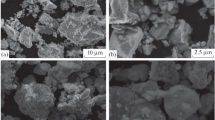Conclusions
The surface of a powder produced by the nitration of titanium by the SHS method is covered with a titanium oxynitride film of 8- and 15-Å thickness. For a specimen of low total nitrogen content the [N/Ti]at ratio is much higher in the surface layer than in whole volume of the specimen.
Similar content being viewed by others
Literature cited
A. G. Merzhanov and I. P. Borovinskaya, “Self-propagating high-temperature synthesis of refractory inorganic materials,” Dokl. Akad. Nauk SSSR,204, No. 2, 366–369 (1972).
Inventor's Certificate No. 255221; Byull. Izobret., No. 10 (1971).
L. Ramqvist, K. Hamrin, G. Jahansson, A. Falman, and C. Nordling, “Charge transfer in transition metal carbides and related compounds studied by ESCA,” J. Phys. Chem. Solids,30, No. 7, 1835–1847 (1969).
Yu. M. Shul'ga, V. N. Troitskii, M. I. Aivazov, and Yu. G. Borod'ko, “X-ray photoelectron spectra of scandium, titanium, vanadium, and chromium mononitrides,” Zh. Neorg. Khim.,21, 2621–2624 (1976).
Yu. M. Shul'ga and V. N. Troitskii, “Study of the surface of finely divided titanium nitride by x-ray photoelectron spectroscopy,” Poroshk. Metall., No. 10, 1–4 (1979).
J. Lindau and W. E. Spicer, “The probing depth in photoemission and Auger-electron spectroscopy,” J. Electron Spectry. Related Phenomena,3, 409–413 (1974).
D. N. Hendrickson, J. M. Hollander, and W. L. Jolly, “Nitrogen Nls electron binding energy. Correlations with molecular orbital calculated nitrogen charges,” Inorg. Chem.,8, No. 12, 2642–2647 (1969).
M. Klasson, J. Hedman, A. Berntsson, R. Nilsson, C. Nordling, and P. Melnik, “Escape depth of x-ray excited electrons,” Phys. Scripta,5, 93–95 (1972).
V. I. Nefedov, N. P. Sergushin, I. M. Band, and M. B. Trzhaskovskaya, “Relative intensities in x-ray photoelectron spectra,” J. Electron Spectry. Related Phenomena,2, 383–403 (1973).
V. I. Nefedov, N. P. Sergushin, I. M. Band, M. B. Trzhaskovskaya, and T. V. Salyn, “Relative intensities in x-ray photoelectron spectra, Part 2,” J. Electron Spectry. Related Phenomena,7, 175–184 (1975).
S. K. Sen, J. Riga, and J. Verbist, “2s and 2p x-ray photoelectron spectra of Ti ions in TiO,” Chem. Phys. Letters,39, No. 3, 560–564 (1976).
Author information
Authors and Affiliations
Additional information
Translated from Poroshkovaya Metallurgiya, No. 11(203), pp. 1–5, November, 1979.
Rights and permissions
About this article
Cite this article
Shul'ga, Y.M., Loryan, V.E., Yatsimirskii, V.K. et al. Surface of particles of TiNx-base powders produced by self-propagating high-temperature synthesis. Powder Metall Met Ceram 18, 769–772 (1979). https://doi.org/10.1007/BF00802357
Received:
Issue Date:
DOI: https://doi.org/10.1007/BF00802357




